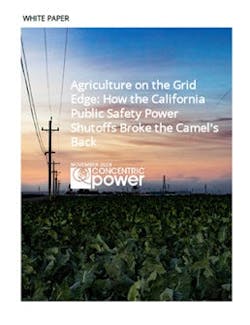For many agricultural and food processing companies in California, operating at the grid edge has become an increasingly risky proposition. To start, the quality and stability of the energy is often poor in agricultural regions. Further, the cost of that energy is unpredictable and continues to see increases.
The Public Safety Power Shutoff (PSPS) events from PG&E recently were made necessary, according to the utility, when “gusty wind and dry conditions, combined with a heightened fire risk, are forecasted.” As California’s dry conditions have worsened in recent years and the risk and severity of wildfires have increased, PSPS events are becoming a new normal for California residents and businesses.
For many decades, the utility industry has operated largely under the legacy structure of centralized power generation that is delivered using the existing transmission and distribution system. However, the energy sector is now evolving due to technology innovations, lower costs, and market-based business models for microgrids.
Technology innovations are changing the game, while public policies and regulations are shifting to allow new business models to gain traction. Combined, the regulatory and policy framework in California has bolstered the outlook of microgrids in the state.
For California’s ag industry, especially at the grid edge, the feasibility of maintaining the status quo is lessening by the day.
The facts in this new white paper from Concentric Power point to a not-too-distant future where microgrids and DERs play an increasingly important role in the state’s energy mix.
